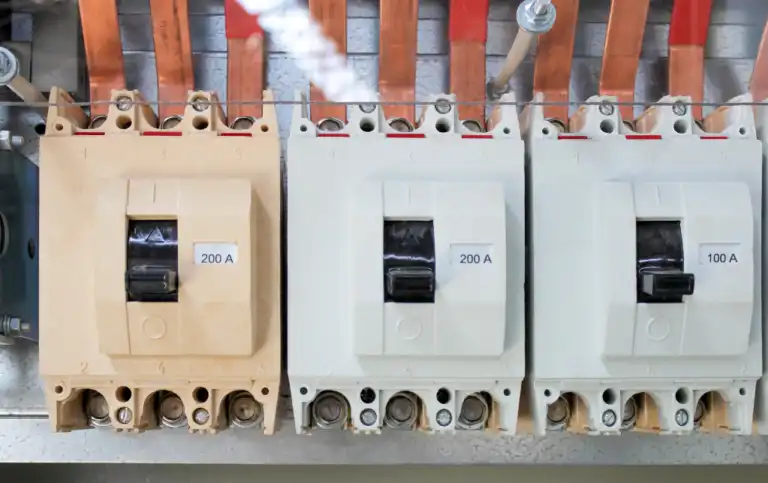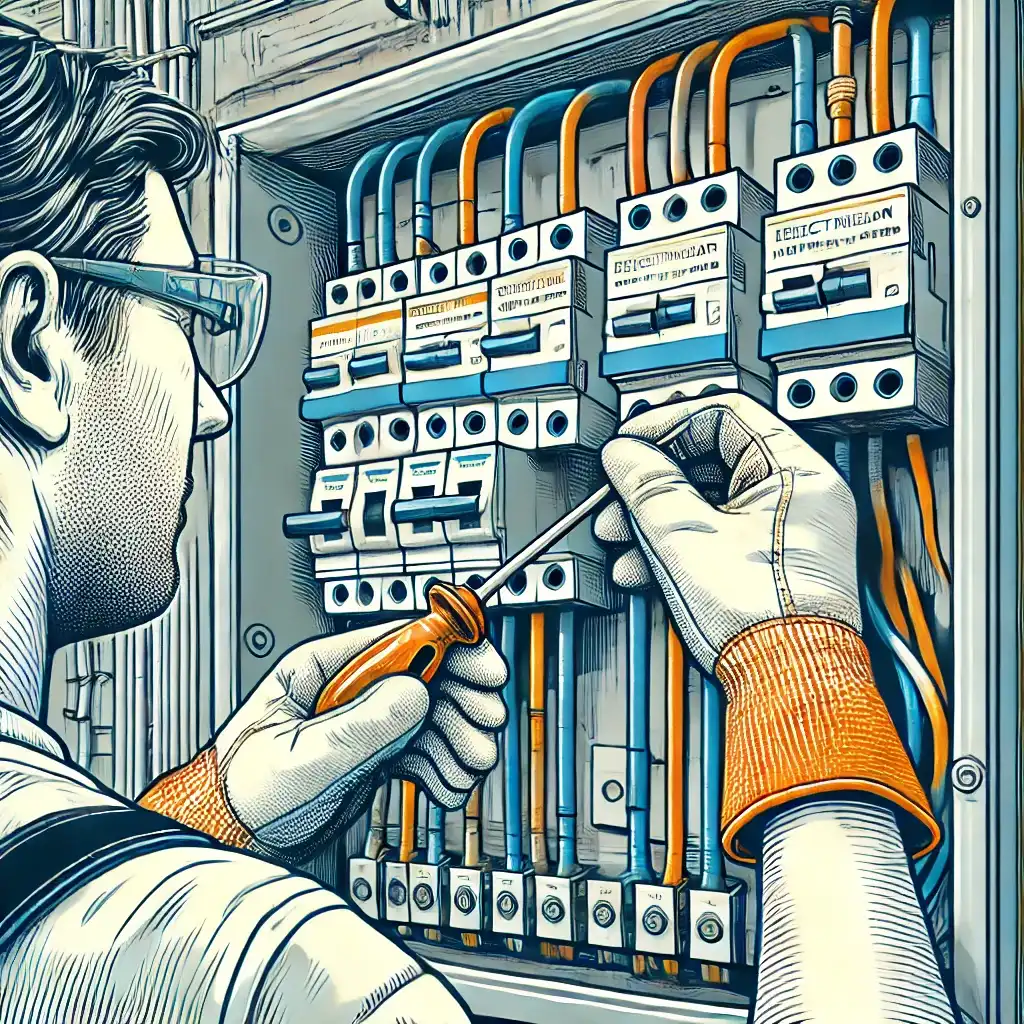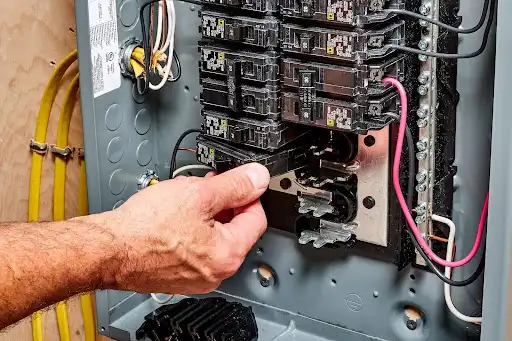Circuit breaker is an electrical protective device whose major function is to protect electric circuits from damage resulting from an overload and short circuit. In the automatic disconnection of the circuit during an abnormal current, the circuit breaker is able to avoid catastrophic consequences such as heating of wires or fire. Periodic checking and replacement of circuit breakers are therefore vital for residential places and business buildings’ electrical safety.
Steps for safely replacing circuit breakers
Fortunately, the circuit breaker is simple to replace. Continue reading to learn how to replace the circuit breaker in the circuit breaker box.
1. Preparation before replacing household circuit breakers
Require the following tools and conditions
- Rubber sole shoes and insulated gloves
- Voltage tester
- New circuit breaker of the same model of the one you are going to replace
- Insulated battery powered light source
- Insulated screwdriver, pliers, and wire stripping pliers
- Cable connector used for connecting the new circuit breaker to the panel
2.Turn off the power and ensure safety
You should unplug all electrical appliances connected to the circuit to be replaced. Then, start preparing to replace the circuit breaker by following these steps:
- Turn on the light source
- Close each circuit breaker
- Close the main circuit breaker of the distribution box to ensure that the entire circuit is without power. If the main circuit breaker is not within sight, it is recommended to hang a lock and attach a warning sign to prevent accidental operation
- Use a voltage tester or pen to confirm that there is no voltage at both ends of the circuit breaker to be replaced
3. Unscrew the circuit board cover.
When disassembling, ensure that the electrical panel does not come into contact with the interior of the main circuit breaker box.
4.Disassemble the current circuit breaker
As a precautionary measure before the existing circuit breaker is disconnected, first observe the installation direction to ensure that the new circuit breaker is installed accordingly.
- Snap a photo or make a note of the existing circuit breaker’s live, neutral, and grounding wire positions to avoid confusion when installing.
- Loosen the terminal block using a screwdriver, strip the wire, and use with caution.
- Finally, gently pull out the old circuit breaker in a way that does not damage any other device.
5.Replace the circuit breaker with a new one.
Then, install the new circuit breaker according to the following steps:
- Ensure that the new circuit breaker is in the closed position, and then install the new circuit breaker
- Reconnect the wires.
- Rotate the terminal screw with pliers until it is tightened
6.Replace the panel cover
Open the main circuit breaker, and then open the remaining circuit breakers. Use a voltage tester to verify if each circuit breaker is energized.
7.Circuit breaker function test
Normal load test: Turn on the light or low-power appliance and observe whether it runs stably.
Leakage test: Press the “test button” on the new circuit breaker to automatically trip
Multimeter testing: measure whether the voltage is stable and confirm that there is no abnormal heating
When should the circuit breaker be replaced?
The circuit breakers last for about 25-30 years and have to be replaced after that. However, if the circuit breaker is defective, you will need to replace it earlier.
At first, if your circuit breaker continues to trip, it means that it has shown signs of wear and tear. If you reset it but still it trips, then it will most likely need to be replaced.
You should also inspect the panel regularly for any indication of rotting. If there are potential dangers with aging circuit breakers, they should be replaced:
- change in color
- rust
- burn smel
- black spot or burn
- wire melting or corrosion
Aside from the panel, you can also look out for other signs that indicate a bad circuit breaker. Your light may flicker or dim when you turn on the appliances. You might even see the socket color change or burn out.
New appliances being installed might also require a new circuit breaker. New appliances require more amperes, which could overload the existing model.
Upgrade to arc fault circuit breaker
For augmenting the safety of home and industrial electricity, the replacement of old circuit breakers with arc fault circuit breakers is recommended.
Arc fault circuit breakers are capable of detecting arc faults in real time, disconnecting circuits in timely manner, and preventing electrical fires caused by wire aging or damage. It provides better accuracy and effectiveness with more accurate detection of potential abnormal arc discharges, and is an essential safety guarantee in modern-day electrical systems.
Maintenance techniques for distribution boards and circuit breakers
Regular maintenance of power distribution panels and circuit breakers is crucial for ensuring household safety and extending equipment lifespan. The following are key tips for maintaining optimal operation of the electrical system:
1. Quarterly inspection: You may inspect the appearance of the circuit breaker yourself on a quarterly basis or arrange to have a certified electrician check your distribution panel once yearly to monitor loose connections or wear and tear.
2. Keep surrounding clean environment: Keep the surrounding area of the distribution panel tidy and free from obstruction. Not only does it provide easy access for emergencies and maintenance, but it also prevents overheating by providing ventilation.
3. Overheating monitoring: Check for discoloration or melting of circuit breakers and other components, which could be indications of overheating.
4. Circuit breaker testing: Periodically open and close circuit breakers to test them. Replace any circuit breaker that cannot switch smoothly.
5. Safety Connection: During inspection, tighten all electrical connections, as loose connections can lead to overheating and fire.
6. Replacement of Old Systems: If your panels or circuit breakers are outdated, consider replacing them with newer equipment such as arc fault circuit breakers (AFCI) and ground fault circuit breakers (GFCI) for greater protection.
7. Circuit Identification: Identify every circuit clearly on the circuit breaker panel to identify easily during maintenance or in the event of an emergency.
8. Doubtful cases: Seek a professional’s services: If you are in any doubt as to whether the repair can be attempted safely, then it is preferable to call a professional electrician.
FAQ
How do I know if the circuit breaker needs to be replaced?
If the circuit breaker trips too frequently or is severely damaged, such as burnt or broken, it usually needs to be replaced.
Can the circuit breaker be replaced when the power is turned on?
No, you must turn off the power and ensure that the circuit is disconnected to prevent injury.
Do I need to use a licensed professional electrician to replace circuit breakers?
If you are not familiar with electrical systems, it is best to seek the help of a certified electrician to ensure safety and compliance.
Conclusion
Replacing circuit breakers is an important step in ensuring the safety of home and office electrical systems. By following the above steps and taking necessary safety precautions, you can effectively complete the replacement work. Please ensure regular inspection of circuit breakers to prevent potential electrical faults and ensure the safety of your home and work environment.
If you need to purchase relays, you can visit our high-quality circuit breaker list or contact us for personalized customized solutions. ONESTO is a professional circuit breaker manufacturer
Here are some information that you may have just been interested in:
How to Replace a Surge Protector Safely and Efficiently
How to Replace a Circuit Breaker Safely in 2025
What is the difference between a circuit breaker and a fuse?





